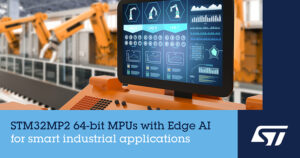STMicroelectronics, a global semiconductor supplier serving customers across the spectrum of electronics applications, has launched the second generation of its STM32 MPUs (microprocessors) with a new architecture built on the same ecosystem and increasing performance and security for applications at the industrial edge and IoT.
 “The new STM32MP2 series devices extend our investment in application processors, combining 64-bit cores with Edge AI acceleration, advanced multimedia capabilities, graphics processing and digital connectivity,” said Ricardo De Sa Earp, executive vice president and sub- general purpose controllers. GM Group, STMicroeletrônica. “Also integrating advanced security features into hardware, the new MPUs are ready for emerging opportunities in secure Industry 4.0, IoT and rich user interface applications.”
“The new STM32MP2 series devices extend our investment in application processors, combining 64-bit cores with Edge AI acceleration, advanced multimedia capabilities, graphics processing and digital connectivity,” said Ricardo De Sa Earp, executive vice president and sub- general purpose controllers. GM Group, STMicroeletrônica. “Also integrating advanced security features into hardware, the new MPUs are ready for emerging opportunities in secure Industry 4.0, IoT and rich user interface applications.”
The first product line of this new generation, the STM32MP25, is available with single or dual 64-bit Arm Cortex-A35 cores running efficiently at 1.5 GHz, complemented with an integrated 400 MHz Cortex-M33 core that handles processing at real time.
A dedicated neural processing unit (NPU) adds up to 1.35 TOPS (tera-operations per second) of optimized computing power for Edge AI acceleration in applications such as advanced machine vision and predictive maintenance. With support for 32-bit DDR4 and LPDDR4 memories, the STM32MP25 ensures long-term support for cost-optimized designs.
Also supporting Gigabit Time Sensitive Networking (TSN) and a two-port Gigabit Ethernet TSN switch, with PCIe, USB 3.0 and CAN-FD peripherals, the STM32MP25 product line provides intensive connectivity for real-time industrial applications, data and gateways and communications equipment.
Combined, the processing and networking capabilities improve feature detection and recognition for security and industrial automation applications. For example, the MPU can acquire video from a 5-megapixel sensor at 30 frames per second (fps), perform analysis with the Edge AI accelerator, and send relevant video (encoding with an HW encoder) with detection metadata leveraging Gigabit Ethernet TSN, all in real-time streaming mode.
A 3D graphics processing unit (GPU) with 1080p resolution for graphics and video capabilities enables rich user interfaces, with support including real-time Vulkan graphics for Android applications. The A1080p encoder/decoder and multiple display connections including LVDS, 4-lane MIPI DSI, and a MIPI CSI-2 camera interface simplify connecting displays and digital cameras, including raw-Bayer image sensors.
State-of-the-art security features that ensure SESIP Level 3 certification include Arm's TrustZone® architecture and Resource Isolation Framework (RIF). This is complemented with secure key storage, secure boot, a unique device ID in single programmable memory (OTP), hardware cryptographic engines, and dynamic DDR encryption/decryption.
The devices are specified over a wide temperature range of -40° to 125° C, facilitating thermal management and increasing reliability in industrial environments. Additionally, like other STM32 MPUs targeted at industrial applications, the STM32MP2 series MPUs come with ST's 10-year longevity commitment.
A selection of package options are offered, including a 0.8mm pitch chip-scale package (TFBGA). This helps facilitate routing of PCB designs and enables cost-effective designs of up to four layers, avoiding expensive laser vias.
Developers using these new devices can take advantage of the extensive STM32MPU ecosystem, which contains the highly popular OpenSTLinux distribution that includes the complete AI framework (X-Linux-AI) and STM32Cube development tools. The STM32Cube firmware will run bare metal or RTOS on the Cortex-M33 embedded core.
ST is now delivering sample STM32MP25 devices along with evaluation boards to selected OEM customers. Volume production of chips and boards is scheduled to begin in the first half of 2024.




